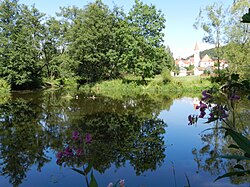Luhe (Naab)
 From Wikipedia - Reading time: 4 min
From Wikipedia - Reading time: 4 min
| Luhe | |
|---|---|
 | |
 | |
| Location | |
| Country | Germany |
| State | Bavaria |
| District | Upper Palatinate |
| Reference no. | DE: 1432 |
| Physical characteristics | |
| Source | |
| • location | east of Waldthurn-Wampenhof |
| • coordinates | 49°42′20″N 12°21′00″E / 49.70556°N 12.35°E |
| • elevation | ca. 630 m |
| Mouth | Naab |
• location | near Luhe-Markt |
• coordinates | 49°34′54″N 12°08′38″E / 49.58178°N 12.14377°E |
• elevation | 378 m |
| Length | 31.6 km (19.6 mi)[1] |
| Basin size | 154 km2 (59 sq mi)[1] |
| Basin features | |
| Progression | Naab→ Danube→ Black Sea |
The Luhe (German pronunciation: [ˈluːə] ⓘ) is a roughly 26-kilometre-long (16 mi) left headstream of the River Naab in the Upper Palatine Forest in Bavaria, southern Germany.
It rises near the hamlet of Wampenhof near Waldthurn, flows through Waldthurn, Roggenstein, Kaimling, past Michldorf and Leuchtenberg and through Lückenrieth and Luhe-Markt. There it discharges into the Naab.
Due to the river's very steep descent, many watermills and hammer forges have been built along its course. Its catchment area is used almost entirely for agricultural purposes with the result that the water of the Luhe is of good quality, enabling many species of fish, crustaceans and mussels to thrive there.
Its most important tributaries are the Trausenbach, the Lerau and the Gleitsbach.
References
[edit]- ^ a b Complete table of the Bavarian Waterbody Register by the Bavarian State Office for the Environment (xls, 10.3 MB)
 KSF
KSF